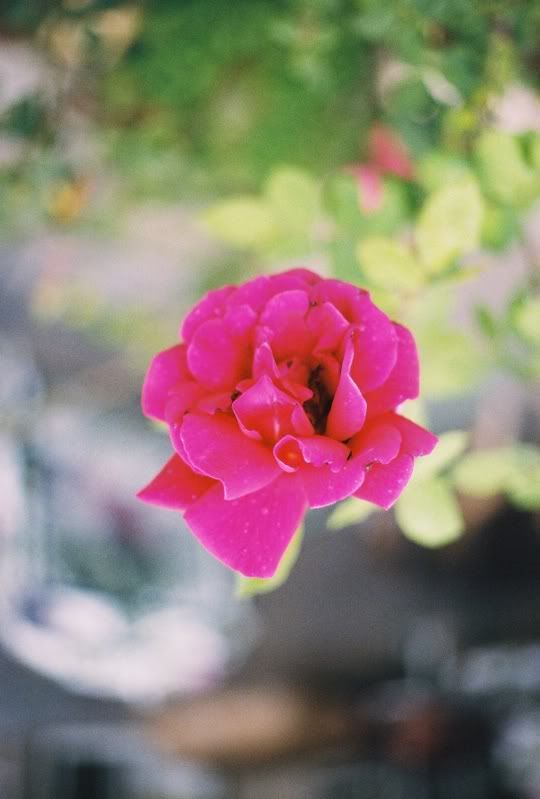
Friday, February 20, 2009
Wednesday, February 18, 2009
Prickly Pear

Prickly Pear Cactus is one of the archetypal images conjured up by publicists to attempt to sell the American Southwest. Hereafter known as SW. Where I live this thing is everywhere. I consulted the OED for some illumination on the etymology of the word cactus. Straight out of Latin. Kaktos in the Greek. Prickly. Lovely. Find another word to define the first one. Wankers.
Prick=Sharp Pointed Stick. Well duh. Did you really expect something else? #17 is the one that refers to the male appendage citing an early reference of 1592. Figured you might be wondering about that.
Most of my family is convinced that my fascination with cactus is a recurrent symptom of mental instability. Australian ranchers in Queensland would probably concur with this. It seems that this plant was brought to that island on purpose. The apocryphal tale that it was brought by an immigrant Texan's homesick wife may have been true of one of the 59 species of these spiny plants, but in 1788 at least one cladode was brought to that continent where it and others of its kind flourished to the tune of 29 million acres.
At that time, Spain and Portugal had a world-wide monopoly on the important cochineal dye industry and the British Government was keen to set up its own source of supply within its dominion. The red dye derived from cochineal insects was important to the western world's clothing and garment industries. It was, for example, the dye used to colour the British soldiers' red coats.
It was at the instigation of Sir Joseph Banks that a cochineal dye industry was established at Botany Bay. Little is known of the fate of those first plants introduced by Captain Phillip, but it has been established that the particular variety of prickly pear brought to Australia in the First Fleet to set up a dye industry was "smooth tree pear" (Opuntia vulgaris). This type of cactus is still found along coastal areas of New South Wales, and is classified as a noxious weed. However, Opuntia vulgaris never developed into a major problem as did some of its relatives - especially Opuntia stricta spp. and O. aurantiacaPrickly Pear History
It didn't work out so well for the settlers of Australia. It is well-documented that it became a noxious pest plant. As any camper, hiker, cowboy, city slicker who has ever had the misfortune to fall into a clump can attest cactus can be painful, decidedly so. The Pear Facts is a nifty little fact sheet concerning its history in that part of the world. In 1925 they decided to give this little bitty moth a try, Cactoblastis cactorum It is called "biological control" when we send one organism to attack another. Ladybird beetles (ladybugs) will eat aphids, but if you become an active participant in the hunt, you too have become organic. So, the Aussies gave it a try. Why not? Fire didn't kill it. Arsenicals not so much. But the very hungry caterpillars? OMG! They never quit! That critter was so successful they built a memorial hall complete with historical stone marker, Boonarga Cactoblastis Memorial Hall. HOWEVER, it is not a welcome immigrant here. At least not to me and a few others. Ranchers might want to take off to Puerto Rico and smuggle back some egg casings if they knew how. Be patient men, it will make it over the Mississippi eventually. The only thing that will slow it down is the cold or other biological characters we bring against it. It is difficult to consider Texas and Mexico without the ubiquitous Opuntia species. Yeah, sure there is a market for nopalitos and tunas, but it is the cultural implications rather than the economic impact that bothers me. There will be no vacuum formed in the panoply of plants that inhabit the SW. Again, the ranchers are scratching their heads wondering why on earth I would want to trade cactus and yucca for grass and forbs. Down in the core of my being I am not too terribly concerned. Prickly Pear will survive this moth attack.
I do not know an easier plant to grow. Take one pad, throw it on the ground and wait. That's it. You don't even have to actually put it in the soil. Merely having one or two aeroles (where the spines are) in contact with the soil is enough for the pad to grow roots.
There are two basic types; dry, green fruited ones and the fleshy purple ones. There are many variations in pad size, spine length, height and distribution. Flower color ranges from a clear yellow to a pinkish red. It is unusual but not rare to see more than one color on a plant due to sporting/mutation. Color is not a species determinant.
Other tales of Prickly Pear? The story goes that when the Aztecs found an eagle perched on a cactus growing from a rock eating a snake that they would build a great city. Tada! Tenochitlan. It was on a Prickly Pear cactus that the caracara ate a rattlesnake in the middle of the swamp. Some say the coyote uses his tail to brush off the spines before he eats the tuna. Yeah, sure sounds great.
It is certainly edible. I like nopalito and potato tacos. The test for palatability of the pads is to snap one in two. If it breaks cleanly without the interior cords being present it is still tender enough to eat. The green fruit probably has some medicinal properties but I do not know them. The purple fruit is sweet, but seedy. Good ones are plum colored, 2-3 inches long and swollen with juice. Since mankind has managed to make booze out of every sugary or carbo-laden plant this one also has been fermented and distilled. Tell me how it tastes, never tried it. Watch out for the tiny hairlike spines called glochids. Duct tape works well to remove these tiny tormenters. Flower petals can be scrambled with eggs. Gotta try that this year. I see nopalito offered in my circle of taquerias around Easter, but I can find it at some year round. The pads are collected, spines removed if present, sliced, parboiled and canned for later use. Bust open a Mason jar of the tart, crisp slices, throw'em in a skillet with some taters and onions and slap that all in a tortilla. Good eatin' my friend.
Cactus isn't for everybody. Prickly Pear does not belong in a bed near the house or any walkway. Out in the median or in some hot, unforgiving corner that bakes in the summer sun is where it belongs. Prickly Pear does not care if you grow it on purpose or not. If you drag chains across it or burn it with fire it will regrow. We have developed chemical controls and it does have a formidable antagonist in the Cactoblastis, but despite all our efforts and under the harshest of circumstances it has and will continue to survive.
Opuntia, from the town in Greece, Opus. 250 species worldwide and 59 in North America. I wonder where I can find some good nopalito tacos today. Perhaps over at Vera Cruz, they have damn good salsa verde too.
Monday, February 02, 2009
A hat for summer

I was asked to post a picture of a hat that cost me $50.
Right over here>>>>>>>>>>>>>>>>>>>>>>>>>>>>>>>>>>>>>>>>>>>>>>>>>>>>
It has served me well. It keeps the rain off my head, soaks up the sweat fairly well and does not generally fly off when the wind blows in 30mph gusts. I do have to screw it on a little tighter on those days, but so far I haven't had to chase it very often. Hats are not a fashion statement for me, they are an integral part of my work clothes. I will spend extra on a good hat that I know will last me a solid season and not fall apart under duress. Since it is winter it has sat patiently awaiting the return of the sweaty seasons. It will soon be back in service.
Subscribe to:
Posts (Atom)

